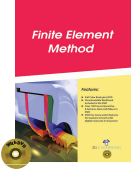Engineering and Technology

Finite element method (FEM) is a numerical method for solving a di erential or integral equation. It has been applied to a number of physical problems, where the governing di erential equations are available. The method essentially consists of assuming the piecewise continuous function for the solution and obtaining the parameters of the functions in a manner that reduces the error in the solution. In this book, a brief introduction to nite element method is provided. Therefore, a nite element method is a numerical technique to obtain an approximate solution to a class of problems governed by elliptic partial di erential equations. Such problems are called as boundary value problems as they consist of a partial di erential equation and the boundary conditions. The nite element method converts the elliptic partial di erential equation into a set of algebraic equations which are easy to solve. The initial value problems which consist of a parabolic or hyperbolic di erential equation and the initial conditions (besides the boundary conditions) cannot be completely solved by the nite element method. The parabolic or hyperbolic di erential equations contain the time as one of the independent variables. To convert the time or temporal derivatives into algebraic expressions, another numerical technique like the nite di erence method (FDM) is required. Thus, to solve an initial value problem, one needs both the nite element method as well as the nite di erence method where the spatial derivatives are converted into algebraic expressions by FEM and the temporal derivatives are converted into algebraic equations by FDM.